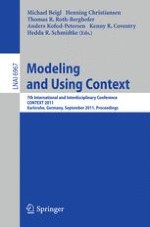2011 | Buch
Modeling and Using Context
7th International and Interdisciplinary Conference, CONTEXT 2011, Karlsruhe, Germany, September 26-30, 2011. Proceedings
herausgegeben von: Michael Beigl, Henning Christiansen, Thomas R. Roth-Berghofer, Anders Kofod-Petersen, Kenny R. Coventry, Hedda R. Schmidtke
Verlag: Springer Berlin Heidelberg
Buchreihe : Lecture Notes in Computer Science
